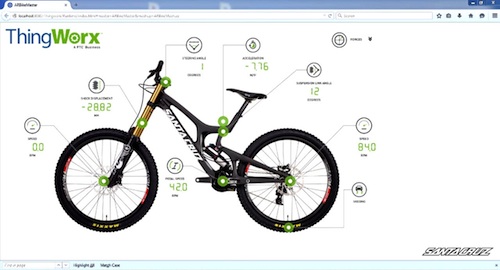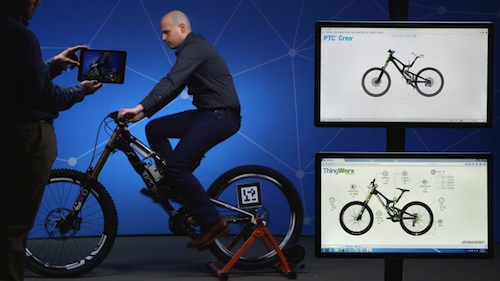
Latest News
May 7, 2015
While PTC‘s latest acquisition target of a Big Data company fits squarely with its strategy to dominate the Internet of Things (IoT) market, it definitely draws the firm further away from its roots as a CAD and PLM (product lifecycle management) provider.
At its second annual LiveWorx conference held earlier this week, PTC inked a $105 million deal to acquire ColdLight, a provider of Big Data machine learning and predictive analytics, filling in a key piece of its IoT technology stack. Counting its latest conquest, PTC has doled out $500 million on core IoT technology in the last 18 months, including the $112 million acquisition of ThingWorx, which makes a platform for IoT application development, and last year’s $170 million purchase of Axeda, which brought IoT and Machine to Machine (M2M) connectivity services into the PTC fold.
ColdLight’s automated predictive analytics platform will help facilitate the analysis of data streaming off of all of those smart, connected products that PTC and industry watchers project will dominate in every field. While data is the currency of the new IoT era, the data has to be mined for insights that can drive specific actions — say predicting an equipment failure or making a recommendation for a service fix. ColdLight’s Neuron platform uses artificial intelligence and machine learning to automatically and continuously learn from data, helping to discover patterns, build validated predictive models and mash up those findings with any type of application or technology to initiate an action.
PTC sees the ColdLight Big Data capabilities as a natural complement to its IoT-driven after-sales and service application strategy. It plans to use the platform to accelerate creation of predictive analytics applications to support service strategies in such areas as predictive maintenance and system monitoring and rounding out its existing Service Lifecycle Management (SLM) suite.
In fact, one of ColdLight’s strengths lies in its ability to simplify predictive modeling and analysis — a discipline that typically requires expert data scientists, which are fast becoming a rare and highly-prized breed. “Analytics are a core part of an IoT solution, and ColdLight democratizes analytics making it approachable by people who are not data scientists,” said Jim Heppelmann, PTC’s president and CEO, during the LiveWorx 2015 show where the acquisition was announced.
In addition to the ColdLight deal, PTC announced ThingWorx 6.0, which focuses on scalability and security improvements, and ThingWorx Converge, technology that extends the ThingWorx platform with pre-built capabilities to make it easier to integrate the real-time sensor data into existing enterprise applications like ERP (enterprise resource planning) and most importantly, Windchill PLM. Converge includes an out-of-the-box data model and other capabilities that will make it easier to monitor, manage, access and control IoT connected products.
While ThingWorx, Axeda and the various related technologies were definitely the LiveWorx show stealers, PTC also demonstrated how its foundational CAD and PLM platforms will play an important place in its vision of IoT product design. As part of a technology demonstration, the company showed off its vision of a digital twin, which bridges a physical product — in the case of the demonstration, a sensored mountain bike — with its digital prototype. Unlike a traditional 3D CAD model, the digital twin displayed in Creo goes far beyond a 3D geometric representation of a product to include everything from sensor data, configuration information, service information, bill of materials (BOM) capabilities and more.
 On tap for future versions of Creo and Windchill will be tight integration with sensor data to support PTC’s vision of smart, connected products. Image courtesy of PTC.
On tap for future versions of Creo and Windchill will be tight integration with sensor data to support PTC’s vision of smart, connected products. Image courtesy of PTC.“The 3D digital twin is a broader representation of the digital product,” said Mike Campbell, PTC’s executive vice president of the CAD division, adding that the digital twin is critical for engineers and service technicians to stay in tune with what’s happening to a “thing” or smart, connected product after it is out in the field with a customer. Having that data stream directly integrated with engineering tools like CAD and PLM (think the new ThingWorx Converge), engineers can get direct feedback into how a product is used helping to optimize designs beyond what Campbell says can be an idealized set of requirements while ensuring that a product is not over designed.
 PTC’s technology demonstration at LiveWorx 2015 used augmented reality and a sensored mountain bike to show what’s possible with smart, connected products. Image courtesy of PTC.
PTC’s technology demonstration at LiveWorx 2015 used augmented reality and a sensored mountain bike to show what’s possible with smart, connected products. Image courtesy of PTC.In the example PTC showcased, a digital twin of a sensored mountain bike was coupled with augmented reality capabilities to depict a number of factors, including how changes in speed or weight affect performance. To hear Campbell talk more about the digital twin and see the demonstration, check out this video.
Subscribe to our FREE magazine, FREE email newsletters or both!
Latest News
About the Author
Beth Stackpole is a contributing editor to Digital Engineering. Send e-mail about this article to [email protected].
Follow DE





